Most people have sufficient strength for every day life without doing specific strength training.
It involves overloading the muscles. Initial strength gains from training are due to increased neuromuscular system activation within the muscles and ‘tones’ them up. This may be associated with improved body definition and shape. Continued resistance training will eventually lead to hypertrophy - or an increase in the size of the trained muscles. It is specific to the trained muscle only.
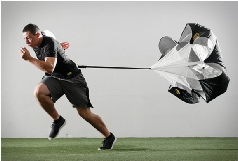
The following changes occur with Strength Training
- Increased glycogen and protein storage within the muscles
- Increased blood flow in the muscle
- Increased biochemical activity among the enzymes that release the energy from the fuel stores in the muscle
- Increased myofibrils / muscle fibres in action
- Recruitment of neighbouring motor units.
There are three types of strength training
- Isotonic - where the resistance / load is constant but speed can be varied
- Isokinetic - where the speed is constant but the load / resistance can vary
- Isometric - exercise against immovable object but muscle remains at same length. Back to Top
Strength Resistance Training
This refers to explosive type strengthening exercises. It is most suitable to those who compete in sport where an explosive movement is an inherent component in the sport activity. This may take the form of fast speed exercises, fast functional exercises or plyometrics.
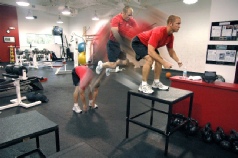
Muscle Power Training
Training is the process of acquiring or adapting / improving / developing a skill or behaviour. It encompasses organised activity aimed at imparting information or instructions in order to;
1. improve a person’s performance or
2. achieve a greater level of skill or knowledge
In relation to physiotherapy, exercise or sports medicine, training means stimulating functional adaptations to improve performance in specific physical tasks. Training programmes use a blend of the following elements to achieve focused results
- Different types of training
- Frequency and length of workouts
- Intensity, speed and duration of exercise
- Repetition
- Rest / recovery
- Appropriate competition - graded return to sport
A New Years’ Resolutions may be the first introduction to ‘training’ a person gets
Training




The most successful training programmes are carefully planned out and executed. They are
- Creative and keep the person challenged but interested,
- Realistic and achievable
- Goal orientated for the person undertaking the training
- Can be adapted according to progress
- Rewarding with improvements in performance obvious
Training Goals are adapted as necessary as needs change.
Training usually begins with general training and moves increasingly to more task specific training for specific skills.
Training Programme

This training is for the neurological control mechanisms of movement. It includes functional training
It is important in the development of basic motor skills of work or sport. Once acquired, skills can then be put together to create a ‘pattern’ of movement.
Speed and power can be added later as required.
Maintaining control of posture, stability and balance during the execution of required movements is paramount.
Normal ‘control’ depends on normal intact sensory signals getting to the brain, which it processes before producing the required motor (outgoing) signals to the muscles to produce movement.
Problems in either neural pathway may produce a less than optimal movements i.e. after an ankle sprain the sensory nerves are injured and an athlete may be aware their ankle is turning over again and so cannot prevent it doing so. With appropriate retraining the motor response could be improved and the risk of future injury minimised.
Progression of this training includes increasing the complexity of the activity i.e. from walking to jogging, to running, to running with a ball, to running in and out of cones with ball, to running and kicking ball at a target, to tackling against an opponent with ball. Back to Top
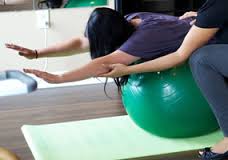
Neuromuscular Control Training
Balance / Proprioceptive Training
Flexibility training is more than simple stretching. It has attracted controversy for some time.
Stretching will affect both muscles and ligaments.
Excessive flexibility can be problematic. Joints that are too flexible (hypermobility) are at higher risk of injury. Over stretched muscle may become weaker and less effective in producing, or controlling, movements.
Potential benefits include
- Reduced muscle soreness
- Reduced muscle tension
- Increased relaxation
- Reduced muscle resistance to opposite movement
- Improved muscle extensibility
- Increased joint range of movements
- Improved circulation
- Reduced adhesion between tissue layers (following injury)
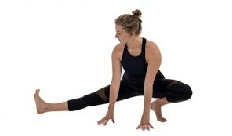
Flexibility Training should take account of the following:
- Be preceded by a short period of warm up with steady exercise
- Correct posture and technique are important
- Dynamic stretches should be done prior to training and Static stretches should be emphasised after training.
- Slowly apply a stretch - muscles have a protective stretch reflex against a sudden stretching force.
- Static stretches should be applied slowly and held for > 15 secs. even longer for stretches to lengthen the muscle.
- For dynamic stretches slowly build up the range of movement while gradually increasing speed of movement.
- Exhaling (breathing out) will assist with stretching.
- To develop flexibility you must stretch more frequently, for longer and push to the very end of available movement.
- Flexibility can be maintained by frequent stretching.
Flexibility should be enough to permit normal, safe movements needed for an activity. Excessive flexibility may lead to instability around the joints and can reduces dramatically the force that an over stretched muscle can exert.
Dynamic stretching is preferred over static stretching prior to training / competing - as it causes short term muscle weakness.
Ballistic / bouncing stretching movements are normally not recommended unless it is a movements appropriate + specific to that sporting activity. It should always be performed with care.
Flexibility Training
Speed is largely an inherited ability but it can be improved by training. Strength and power are key requirements and so speed training will include resistance and power training.
Increasing stride length & cadence helps increase ground coverage.
Running and technique drills will also help to develop speed.
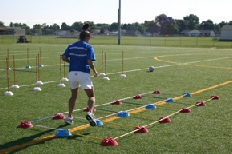
Agility and reflexive responses are also largely inherited characteristics. However they do improve with training. The exercises should be sport/activity specific and reflect the movement patterns used within a sport/activity.
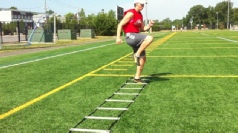
Speed & Agility Training
This refers to training the cardiovascular system to get oxygen to the muscles efficiently and removal of CO2, lactate + water.
Training causes more O2 to be taken into the bloodstream (deeper + more rapid breaths), and so more oxygen is delivered to the muscles (deeper + more rapid beating of the heart, opening up of more blood vessels). The reverse systems will remove the by products of muscle work (water and lactate) more quickly also.
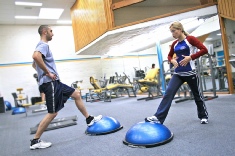
Heart Rate (HR) is often used as an indicator of fitness.
HR can be used as a measure of the intensity of training. HR based training begins with low intensity / load training but can include other types of training such as anaerobic and aerobic interval training.
Cross training in different sports is often used for this type of training to maintain interest and variety in training. Back to Top

Cardiovascular Training
Principles of Training Training Programmes
Rehabilitation Endurance Training
Muscle Power Training Flexibility Training
- Overload Principle; The muscles and the body’s systems must be repeatedly and increasingly overloaded in order to see an ongoing training effect.
- Specificity Principle; Training exercises are required to enhance the physiological, metabolic and psychological adaptations required to improve performance. “Specific exercises illicit specific adaptation to create specific training effects”.
- Individual Differences Principles; Many factors contribute to the training responses seen in each individual – initial strength and fitness, motivation, fears, age, sex all have an impact.
- Reversibility Principle; A rapid loss of performance adaptation will occur if the person stops regular training in a specific action or skill – known as detraining.
Principles of Training

A good training programmes is
- Specific to the ultimate goal of the training
- Specific for the blend of strength, flexibility, endurance and power needed to achieve the goals set.
- Specific in the frequency and duration to achieve the required performance – improving performance needs more training than maintaining performance.
- Creative in providing variety in training methods
- Adaptable to allow sufficient recovery between sessions
- Planned to maximise progression at an achievable rate
Training programmes are planned in blocks of time - periodisation - taking account of the goals are for that period.
By benchmarking progress against set goals one can adjust training accordingly + can make informed decisions on return to play / work etc.
Certain elements of training maybe prioritised over others
Achieving the goals of the training programme helps boost confidence + self belief and improves the likelihood of achieving the ultimate goals of the programme. Having goals allows an objective review of progress to to be made. Back to Top
Rehabilitation (Rehab) is the process of training for recovery following an injury, in order to restore someone to their former functional capacity, or even better.
The ultimate goal is to return to play, or function, in the shortest possible time or to achieve a standard of performance that is either equal to, or greater, than existed pre-injury.
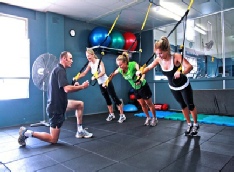
Rehabilitation
The ‘art’ of rehabilitation is using knowledge of tissue healing + recovery to create a programme that takes account of the goals of the injured person, the type + severity of the injury, the social, psychological, physical and environmental resources available to the person. It is by successfully managing these that the best possible outcome is achieved.
The lifestyle factors / demands on an individuals, their self confidence, motivation + fears will impact on the creation of a personalised programme.
Precise, clear guidance must be provided with appropriate monitoring and correction as necessary.
Rehab starts immediately an injury occurs and continues after the person has returned to sport / normal daily life!
Components of a Rehabilitation Programme may include;
- Muscle Activation, re-education, timing +‘patterning’
- Muscle strengthening / conditioning
- Muscle Endurance
- Soft tissue flexibility (muscle + joint)
- Neuromuscular Control - Balance + co-ordination
- Functional Activities / Work + Sport Specific Drills
- Cardiovascular Fitness
- Psychological Fitness – fear reduction, motivation,
- over zealousness, mental toughness
Endurance Training, also known as Aerobic Training, aims to increase the body’s the ability to use O2 to release energy from glycogen. It has the muscles doing repeated contractions over prolonged periods. Endurance training should be done alongside strength training.
To improve endurance it is necessary to improve the efficiency of the aerobic energy pathways for fuelling the muscle. This is measured by VO2max - the maximal rate at which O2 can be consumed + increases with training. It can be measured by using Heart Rate (HR) at a given exercise intensities.
 Aerobic Training effects are achieved with sub maximal training at an intensity of 70-85% of maximal HR (220 - Age). This involves high repetition muscle contraction under low loading i.e. by slow steady running or cycling, swimming, circuits.
Aerobic Training effects are achieved with sub maximal training at an intensity of 70-85% of maximal HR (220 - Age). This involves high repetition muscle contraction under low loading i.e. by slow steady running or cycling, swimming, circuits.
The changes that occur include:
- Increased cell mitochondria numbers + activity
- Increased muscle glycogen
- Increased use of free fatty acids (FFAs)
- Increased blood flow in muscles
- Cardiovascular effects including
- Lower Heart rate
- Lower blood pressure
- Increased stroke rate and volume
Increased endurance is specific only to the muscles used in the exercise / activity and there is no cross benefit to other muscle groups. Back to Top
Muscle Endurance Training



Pain should not be ignored but equally should not deter someone from completing their rehab programme.
While severe pain can negatively affect muscles some pain may be considered a normal consequence of doing a rehab programme.
Stimulating healing in tissues by increasing activity and using the overload principle to increase tissue strength helps exercised tissues to withstand more stress during activity. Therefore some pain is likely during rehab and must be managed rather than be avoided.
In rehab we try to keep pain bearable – too much pain + you reduce the exercise load and if little or none is felt then it is safe to progress the intensity / duration / resistance of the session.
In general it is best to increase only one aspect of the exercise at a time (weight, reps, duration etc) and review the effects during the following hours after the session Back to Top
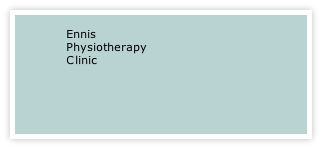




Mon - Fri 9.30am - 8.30pm


3A Barrack Close, Barrack St., Ennis, Co. Clare V95 X437

065 6840757
| Health+Safety Services |
| Sports Clubs+Teams Services |
| Standing Posture |
| Sitting Posture |
| Childhood Posture |
| Using Portable Devices |
| Normal Walking |
| Running |
| Running Drills Videos |
| Muscle Energetics |
| General Fitness |
| Losing Body Weight |
| Gaining Body Weight |
| Weight Loss Programmes |
| Start to Run |
| Start to Swim |
| Start Cycling |
| Start Nordic Waliking |
| Rehab of Tensdons |
| Loading of Tendons |
| Non Specific LBP |
| Posture |
| Intervertebral Disc |
| LBP Treatment |
| Non Specific Neck Pain |
| Neck Care Advice |
| Hamstring Strain |
| Ankle Sprain |
| ACL Injury |
| Joint Replacement |
| Shoulder Dislocation |
| Tennis Elbow |
| Wrist fracture |
| Fractured Knuckle |
| Selecting a Racquet |
| Racquet Grip Size |
| Racuet Sport Injuries |
| Training for Racquet Sports |
| Ski + Board Injuries |
| Injury Videos |
| Injury Prevention |
| Preventing Injury in Musicians |
| Irish Dancing |
| Preventing Dance Injury |